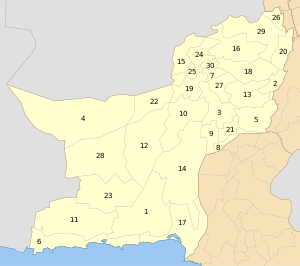Pishin District
Pshin or Pxin (Pashto: پښين; Urdu: پشین) is a district in the Balochistan province of Pakistan. In 1975 it was separated from Quetta District, while in 1994 part of it was split off to form the new district of Killa Abdullah.[4] The name Pishin is a modernized form of ‘Pushang’, which is how the city was designated in (mainly pre-modern) Persian sources (Arabic sources using 'Fushang'). Myth attributes the origin of the Persian designation to a son of the mythical Emperor Afrasiab. Fushing was the spelling used in the records of the Afghan government. The population of Pshin District was estimated to be over 300,000 in 2005.[5] According to the 1998 census, the predominant first language in the district was Pashto, accounting for 99% of the population.[6]
Pshin District | |
|---|---|
| District Pshin | |
 Map of Balochistan with Pishin District highlighted | |
| Country | Pakistan |
| Province | Balochistan |
| Division | Quetta Division |
| Headquarters | Pishin |
| Government | |
| • Deputy Commissioner | Abdul Wahid Khan Kakar[1] |
| • Assistant Commissioner | Samee Ullah Kakar[2] |
| Area | |
| • Total | 7,819 km2 (3,019 sq mi) |
| Population (2017)[3] | |
| • Total | 736,481 |
| • Density | 94/km2 (240/sq mi) |
| Time zone | UTC+5 (PST) |
| Number of Tehsils | 5 |
Agriculture and Farming
Main crops in the area are wheat, barley, corn (maize), potatoes, grapes, apples, apricots, and peaches which are grown in the valleys. Sheep and goats are also herded.[7]
The district is represented in the Provincial Assembly of Balochistan by three constituencies.[8]
- Syed Mussa Jan Agha Shaheed (Karbala)[9]
- Abdul Malik Kakar [9]
- Sardar Mustafa Khan Tareen [10]
- haji israel kako from kamalzai[11]
- Syed Liaqat Agha Agha[12]
Administration
The district of Pishin is administratively subdivided into four tehsils,[13] and one sub Tehsil:[14]
- Pishin
- Karbala
- Barshore
- Karezat
- Huramzai
- Saranan sub-Tehsil, [http://www.pbs.gov.pk/sites/default/files/bwpsr/balochistan/PISHIN_SUMMARY.pdf
Notable people
- Kader Khan, Indian actor[16][17]
- Jennifer Musa, politician
- Jehangir Ashraf Qazi, diplomat, former Pakistani ambassador to United States
- Sultan Golden, motorcycle stuntman
- Sarwar Khan Kakar, politician
- Qazi Faez Isa, Justice in Pakistan Supreme Court
- Haji Malik Muhammad Rahim Khan Kakar, Tribal chief and politician<ref>{{web|url=http://pabalochistan.gov.pk/new/members-page/?id=221%7Cpublisher=Provincial Assembly Balochistan
Karbala syed haji Muhammad saleem was the chief of karbala and also chief of all syedes
See also
References
- "Eight NGO workers abducted in Pishin | Pakistan Today". pakistantoday.com.pk. Retrieved 2016-05-14.
- http://nchd.org.pk/ws/downloads/District%20Pishin.pdf
- "DISTRICT WISE CENSUS RESULTS CENSUS 2017" (PDF). www.pbscensus.gov.pk. Archived from the original (PDF) on 2017-08-29.
- PCO 2000, p. 1.
- "Home - Government of Balochistan". balochistan.gov.pk. Archived from the original on 2016-06-02. Retrieved 2016-05-14.
- PCO 2000, p. 18.
- "Pishin | Pakistan". Encyclopædia Britannica.
- "Welcome to the Website of Provincial Assembly of Balochistan". pabalochistan.gov.pk. Retrieved 2016-05-14.
- "Welcome to the Website of Provincial Assembly of Balochistan". pabalochistan.gov.pk. Retrieved 2016-05-14.
- "Welcome to the Website of Provincial Assembly of Balochistan". pabalochistan.gov.pk. Retrieved 2016-05-14.
- tribal elders
- "Welcome to the Website of Provincial Assembly of Balochistan". pabalochistan.gov.pk. Retrieved 2016-05-14.
- Tehsils & Unions in the District of Pishin - Government of Pakistan Archived 2012-03-26 at the Wayback Machine
- "Pishin". visitorsheaven.com. Archived from the original on 2016-07-11. Retrieved 2016-05-14.
- PCO 200, p. 7.
- "Biography of Kader Khan". OneIndia. Retrieved 2011-07-20.
- "Biography of Kader Khan". Filmy Friday. 2009-04-14. Retrieved 2011-07-20.
Bibliography
- 1998 District census report of Pishin. Census publication. 113. Islamabad: Population Census Organization, Statistics Division, Government of Pakistan. 2000.
External links
| Wikimedia Commons has media related to Pishin District. |
